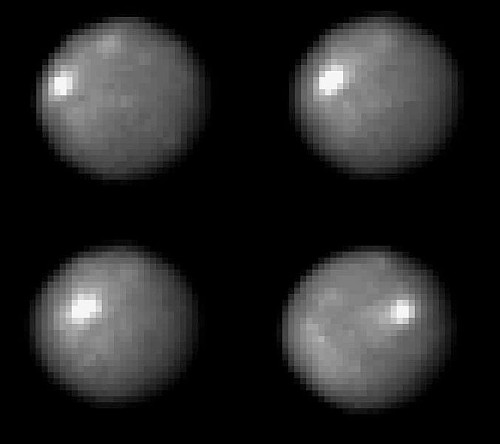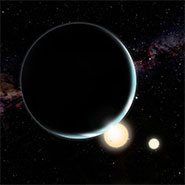Learning that liquid water may exist beneath the surface of more than a few Solar System objects naturally raises astrobiological questions. But as Caleb Scharf notes in Water Erupts Across the Solar System, a much larger issue is whether the kind of chemoautotrophic microbes we find on Earth (Scharf calls them ‘rock eaters’) could have evolved there in the first place. Habitats that may support an Earth microbe aren’t necessarily capable of originating their own forms of life, although the question is obviously going to propel much future study.
What strikes me about a number of recent stories in these pages is how much what we see in our own and other solar systems may be the result of planetary migration, which can affect those water-bearing objects. Ceres is a case in point, and it was my reason for bringing up Caleb Scharf’s always interesting blog in the first place. In Scharf’s post, he takes note of the fact that Ceres is a bit too close to the Sun for comfort given its composition. Let him tell it:
So now we come to Ceres, a 600-mile wide body orbiting the Sun in a gentle ellipse that takes it between about 2.55 astronomical units from the Sun to 2.98 in the course of its 1,680 day year. Compared to distant Europa or Enceladus it is in a much more precarious position when it comes to water. This is a zone where there can be sufficient solar heating to cause the ‘boil-off’, or sublimation, of solid ice into the vacuum of space.
A relevant point given the fact that data from the Herschel Space Telescope have revealed what seem to be water plumes coming from the surface of the dwarf planet. Scharf continues:
The current data seem to suggest that this boil-off, like that of a cometary nucleus, is the more likely culprit for Ceres’s watery outbursts – coinciding with its closest approaches to the Sun. However it’s still possible that there is an interior layer where liquid water could exist, warmed by a rocky core and insulated by a frozen crust and prone to cryovolcanic eruption.

Image: Hubble Space Telescope images of Ceres, taken in 2003-04 with a resolution of about 30 km. The nature of the bright spot is uncertain. Credit: NASA, ESA, J. Parker (Southwest Research Institute), P. Thomas (Cornell University), and L. McFadden (University of Maryland, College Park).
You can see the larger question behind all this, one relating to Ceres’ origins. We didn’t find reservoirs of water inside the smaller Vesta during the recent visit of the Dawn mission. Their orbits aren’t that dissimilar, and we’d like to know what factors gave Ceres the water that Dawn will be studying, among many other things, next year when it arrives. The assumption has to be that Ceres formed much further out from the Sun, which would imply a lot of movement in the early Solar System, likely triggered by migration of the giant outer planets. Maybe Dawn’s analysis of Ceres can give us some insights into the puzzle.
I hope so, because I agree with Scharf that “The eruption of water across the solar system is therefore not just a case of planetary indigestion, but another clue to the deeper origins and evolution of all that is around us.” As to why water implies a more distant origin, the ‘snow line’ of our Solar System is out around 5 AU, indicating a zone far enough from the Sun that water can condense into solid ice grains. We’re now learning, as we saw recently in Shaking Up a ‘Snow Globe’ Solar System, that main belt asteroids are far more diverse than we used to imagine, with the main belt representing only a small fraction of the initial asteroid population.
Migration of Circumbinary Planets

Planetary migration — the possibility of Jupiter closing to a Mars-like distance at some point in the early system — would have thoroughly mixed objects that formed in much different areas. How likely is such migration? We’re learning as we go, but recent work out of the University of Bristol extends the question interestingly to Kepler-34 (AB)b, a circumbinary planet that orbits not one but two stars. The work, published in Astrophysical Journal Letters, reports computer simulations showing that planets like these would have undergone migration.
Zoe Leinhardt (University of Bristol) is one of the researchers behind this work:
“Our simulations show that the circumbinary disk is a hostile environment even for large, gravitationally strong objects. Taking into account data on collisions as well as the physical growth rate of planets, we found that Kepler 34(AB)b would have struggled to grow where we find it now. Based on these conclusions for Kepler-34, it seems likely that all of the currently known circumbinary planets have also migrated significantly from their formation locations — with the possible exception of Kepler-47 (AB)c which is further away from the binary stars than any of the other circumbinary planets.”
Image: An artist’s conception of Kepler-34(AB)b which orbits a double-star system. Credit: David A. Aguilar, Harvard-Smithsonian Centre for Astrophysics.
Then, of course, we have the case of abundant ‘hot Jupiters,’ themselves thought to be the result of migration, forming well beyond the snow line but migrating through gravitational interactions to their present positions. Clearly issues of planetary migration are going to stay in the forefront of our attempt to understand how the planetary systems we observe evolved over time, and our own system gives us plenty to consider, as a watery Ceres reminds us.
The Kepler-34 (AB)b paper is Lines et al., “Forming Circumbinary Planets: N-body Simulations of Kepler-34,” Astrophysical Journal Letters, 2014, vol. 782, L11 (abstract / preprint).



We seem to be finding water everywhere – even on our Moon. Contrast this understanding with that of our solar system a scant 25 years ago, and it’s clear that our worldview has significantly changed over a relatively short time. In pragmatic terms, the chances of finding at least microbial life has increased, as has the ease with which we can undertake colonisation and do space-based manufacturing in the future.
Since planetary inward migration seems to be so common, a relevant question then becomes: what makes (giant) planets migrate outward again? Practically: Earth would probably not have been here, or not as a fullsized terrestrial planet, if Jupiter had stayed near its innermost migration point.
@Ronald February 7, 2014 at 10:51
‘Since planetary inward migration seems to be so common, a relevant question then becomes: what makes (giant) planets migrate outward again? Practically: Earth would probably not have been here, or not as a fullsized terrestrial planet, if Jupiter had stayed near its innermost migration point.’
Most likely the gas and dust that was blown back out when the Suns energy dissipated the remaining nebula. But I doubt it very much it had that much mass to pull the gas giants out again as far as they are suggesting.
@Ronald February 7, 2014 at 10:51
‘Earth would probably not have been here, or not as a fullsized terrestrial planet, if Jupiter had stayed near its innermost migration point.’
Maybe this is a big factor in the Great Silence.
Maybe most systems have rock-gobbling close-in gas giants.
Maybe that’s another extreme cosmic fluke in our favor, that Jupiter left us alone.
To David Cummings,
“Maybe most systems have rock-gobbling close-in giants.”
Results from the Kepler mission would suggest otherwise. It would seem most systems may have compact groupings of super Earth/sub-Neptune size planets in their inner system.
Ronald does bring up a good question. It’s a lot easier to model the inward migration of gas giant planets then the outward migration. I have doubts that Jupiter was ever that close in. Perhaps inward migration of the Solar systems giant planets within the outer solar system accounts for the present location of a watery Ceres and the current population in the main asteroid belt. It’s also one of the ways of explaining the Late Heavy Bombardment.